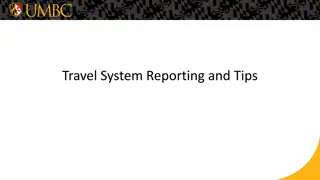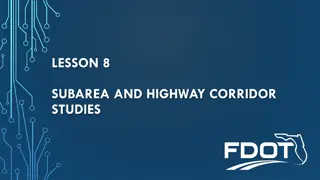
Calibrating Large-Scale Travel Demand Models: Key Issues & Options
This workshop delves into challenges and solutions in calibrating large-scale travel demand models, addressing issues such as auto calibration, transit calibration, and network concerns. Explore strategies to enhance accuracy and efficiency in modeling travel demand.
Download Presentation

Please find below an Image/Link to download the presentation.
The content on the website is provided AS IS for your information and personal use only. It may not be sold, licensed, or shared on other websites without obtaining consent from the author. If you encounter any issues during the download, it is possible that the publisher has removed the file from their server.
You are allowed to download the files provided on this website for personal or commercial use, subject to the condition that they are used lawfully. All files are the property of their respective owners.
The content on the website is provided AS IS for your information and personal use only. It may not be sold, licensed, or shared on other websites without obtaining consent from the author.
E N D
Presentation Transcript
WORKSHOP: CALIBRATING LARGE WORKSHOP: CALIBRATING LARGE- -SCALE TRAVEL DEMAND MODELS: TRAVEL DEMAND MODELS: ISSUES & ISSUES & OPTIONS OPTIONS HDR Perspective: Calibrating the GTAModel for Local Municipalities May 6th, 2020 SCALE
Issues Issues 1. Auto calibration Differences in peak hours and PHFs in areas outside of Toronto 2. Transit calibration Mismatch between calibration/validation sources Calibration of separate transit modes 3. Network issues Transit speeds and feedback with auto speeds 5/6/2020 2
Auto Calibration Auto Calibration 1. Differences in peak hours/PHFs in areas outside of Toronto Issue: Peak times in some areas differ from the network-wide peaks that the GTAM identifies. Thus, applying network-wide PHFs can sometimes lead to an underestimation of peak hour travel demand in these areas. This can also affect the calibration of off- peak directions. Option: Estimating region-specific and directional PHFs which can be applied as a matrix of factors rather than a single number that is applied network-wide. This can be based on a comparison of cross-regional flows in the cordon count database (and other count sources). 5/6/2020 3
Transit Calibration Transit Calibration 1. Mismatch between calibration/validation sources Issue: Under-reporting of transit boardings in TTS (particularly by the younger population who is more likely to use transit) can lead to conflicts when compared to validation count data from transit agencies, particularly at the individual route level. The point is to stress that the TTS undercounts are going to have an impact, which may require bigger adjustments at the assignment stage to match counts more closely (and/or moving away from a close OD calibration to TTS). Option: Could also consider improving response rates and weighting processes, and/or supplementing with additional surveys (e.g. student surveys). 5/6/2020 4
Transit Calibration Transit Calibration 2. Calibration of separate transit modes Issue: Aggregating demand by different transit modes into a single matrix can in some cases lead to challenges in calibrating flows by different transit modes. E.g. over- simulation on GO Rail and under-simulation on surface transit and feeder routes. Option: Splitting out demand by different transit modes into separate demand matrices (though this comes with its own challenges). Another way to address it could be to have more flexibility on the mode-specific transit parameters to try and guide route choice without needing separate matrices, or more clarity on what the existing boarding penalty parameters mean. Another option could be to implement transit mode-specific dwell times in the network coding. 5/6/2020 5
Network Issues Network Issues 1. Transit speeds and feedback with auto speeds Issue: Setting transit speeds a priori can be a challenge. Also, many cases of in- between ROW now exist with LRT lines that may not share road space with cars but still have to follow traffic lights. Option: GTAModel V4.1 now does include auto congestion in transit speed calculations. Still a challenge to determine where LRT fits into the picture. 5/6/2020 6






















